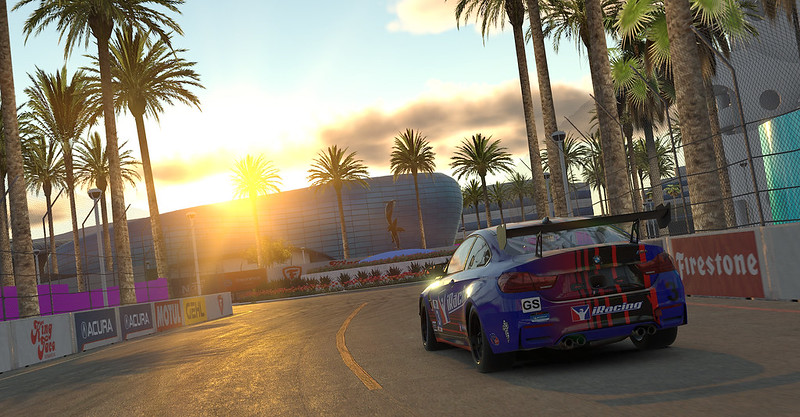
iRacing Long Beach Progress Screenshot
Currently, the iRacing online racing service features the Long Beach street circuit as a “Tech Track”, which is a completely driveable version of the track but isn’t complete in terms of artwork.
Therefore, Tech Tracks are not utilized in official series but are available for hosted races, league races, and testing sessions.
However, a while ago, some iRacing staff members hinted that they were working on a full version of the Long Beach circuit. Today, Senior VP of Product Development at iRacing Greg Hill confirmed that a completed version of the track will become available in iRacing in the near future. Gregg accompanied his statement with a very cool looking WIP screenshot (Top) showcasing the Long Beach marina area featuring the famous turn 2 around the fountain.
A very early teaser of Long Beach. It will be released on iRacing in the future. Lots of work left, but it sure is coming together. This is WIP, so placeholder art is visible, and of course, VFX will hook up the fountain. Can’t wait to share it with you all in more detail soon.
In April 1974, Christopher Pook, a local Long Beach travel agent, and fan of racing brought international attention to Long Beach by putting the city on the racing map.
With the help of 1969 Indianapolis 500 winner Mario Andretti, Pook arranged a Formula 5000 race as a test of the track’s setup. Long Beach went on to host Formula One Grand Prix during one of the greatest racing eras in history. Drivers like James Hunt, who had a spectacular lap one crash at the circuit, immediately gave Long Beach international reverence as the “Monaco of the West.”
In 1977, Andretti out-dueled Niki Lauda at Long Beach and became the first American to win a Formula One Grand Prix in the U.S. Over the years, the skyline of Long Beach has transformed from nondescript, small buildings to state-of-the-art high rises and upscale condominiums.
IndyCar racing is now the premier event. Despite these changes, the track has mostly remained the same. Naturally, the street surfaces have improved, but the hairpin just before the high speed run down Shoreline Drive, which leads to the infamous Turn 2 around the fountain, is as challenging as ever. Long Beach is an American racing icon and always provides for exciting racing no matter what breed of cars are competing.
The current race circuit is a 1.968-mile (3.167 km) temporary road course laid out in the city streets surrounding the Long Beach Convention Center. The convention center actually doubled as the pit paddock during the days of Formula One. The circuit also goes primarily over the former location of The Pike historic amusement zone. The track is particularly noted for its last section, a sharp hairpin turn followed by a long, slightly curved front straightaway that runs the length of Shoreline Drive. The circuit is situated on the Long Beach waterfront and is lined with palm trees (especially along the front straightaway towards the Aquarium of the Pacific), making for a scenic track. Long Beach is classified as an FIA Grade Two circuit.
The circuit has undergone numerous layout changes since the race’s inception in 1975. Alliterations have featured a signature hairpin turn, main stretch along Shoreline Drive, and back stretch along Seaside Way. The first Grand Prix layout measured 2.02 miles and featured two hairpins, one at each end of the Shoreline Drive straightaway. In its early years, the starting line and the finish line were located on different sides of the course.
In 1982, the hairpin turn and the end of the main stretch (turn 1) were removed, and replaced with a 90-degree right turn, followed by a 90-degree left turn. When the race became a CART series event, the layout was changed significantly. The final turn hairpin was moved to the east, closer to the pit entrance. Other slow chicanes and turns were removed. After a minor tweak to the layout in 1987, the track was shortened in 1992 by the removal of the Park Avenue loop. That created a longer Seaside Way backstretch and a faster run to the passing zone.
In 1999, due to new construction in the area, the turn one set of curves was removed, and replaced with the new fountain complex. Turn one now became a 90-degree left turn, leading into a roundabout around a fountain, and a series of three 90-degree turns. A year later, this segment was revised again, to create a longer straightaway leading to Pine Avenue. This course layout remains intact today. (Source: Wiki)
Official Webpage – www.iRacing.com |
 Bsimracing Sim Racing Resources and News for the racing enthousiast.
Bsimracing Sim Racing Resources and News for the racing enthousiast.









